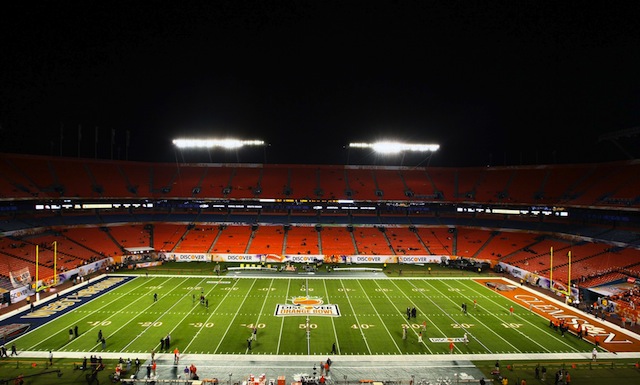There will be a separate time to comment on how college football can improve its bowl attendance numbers, but in this post, we’ll focus solely on giving you a reasonably expansive overview of the attendance situation as it relates to the bowls. You’ll find a lot of links and some videos to help flesh out the reality of the bowls after this flood of 38 games from the previous few weeks.
*
The best work on bowl attendance was done by USA Today’s Brent Schrotenboer in this piece.
Ken Fang, from our friends at Bloguin partner site Awful Announcing, provided this very helpful piece of contextual analysis.
The great website FBSchedules.com tracked bowl attendance on various levels, providing a great resource for anyone interested in studying bowl attendance. Do note that the Orange Bowl attendance figure of 58,211 was clearly a tickets-distributed number, not a “bodies in the house” number.
Want proof?
Look at video of the Orange Bowl (embedding was disabled). Go to 25:52 and 52:49 for panoramic shots of Sun Life Stadium and how empty its upper deck actually was. There’s no way more than 45,000 people were in that stadium, and it’s very likely fewer than 40,000 human beings were in the house to watch Mississippi State and Georgia Tech on Dec. 31.
The listed Cotton Bowl attendance of just over 71,000? It seems fairly accurate as a measurement of people in the house. Here’s video of that game (embedding also disabled).
Here’s another helpful overview of bowl attendance from the Charlotte Observer.
*
How does this all compare to the Bowl Championship Series era? When at my previous employer, I produced this compendium of BCS bowl stats, with an extensive subsection on BCS bowl attendance during the system’s 16 seasons.
To unpack that BCS bowl era section a little bit, let’s first mention the attendance figures for the Rose and Sugar Bowl playoff semifinals.
The Rose checked in at 91,322, the Sugar at 74,682. In 2014, the Rose hit 95,173 and the Sugar 70,473. (The 2014 Rose Bowl, of course, was the prelude to the BCS title game in Pasadena. That game between Florida State and Auburn drew 94,208.)
In the first year of the College Football Playoff, it seems clear that ticket sales did not experience any sort of meaningful rebound, relative to the trends of past seasons. Setting aside the time and money to go to a bowl game remains difficult, especially with airfare and lodging built into the equation.
More specifically, it was a very big ask to expect Florida State fans to travel across the country for the Rose Bowl against Oregon, knowing that a national title trip to suburban Dallas was possible a week and a half later. Many FSU fans made the perfectly reasonable and sensible decision to skip the trip to Pasadena (making it Oregon’s stadium), hoping to go to JerryWorld for the title game if the Seminoles got there.
For the Sugar Bowl, the attendance of under 75,000 was roughly 5,000 seats short of the top BCS national title game crowd at the Superdome (during the BCS era, not previous eras). The 2008 BCS National Championship Game between LSU and Ohio State stuffed 79,651 into the Superdome. At least a few Ohio State and Alabama fans likely wanted to save a little dough (and a trip) for Jan. 12 instead of making two trips. How many families or individuals can pull that off, after all?
If you go back and look at my BCS bowl era fact sheet with its notes on BCS bowl attendance figures, you’ll see that the crowd of under 70,000 for the Fiesta Bowl was not particularly unusual, keeping in mind that in the 2006 season, the BCS expanded from a set of four games to five, diminishing the centrality of the Fiesta and other non-Rose BCS bowls when those bowls were not championship games. In general, nothing about the New Year’s Six bowl attendance figures, provided here, reflected any sort of upward trend in attendance. TV ratings, yes, but not attendance, as other links in this compendium have shown.
For all the ways in which college football scheduled differently this bowl season, and for all the ways in which the sport had a noticeably different feel, the reality of sliding bowl attendance did not change. The more some dynamics might shift, the more they stayed in place as far as bowl attendance was concerned in December of 2014 and January of 2015.
*
How can college football put more fans in a better position to attend bowl games? That’s what we’ll discuss in an upcoming article. Stay tuned.
